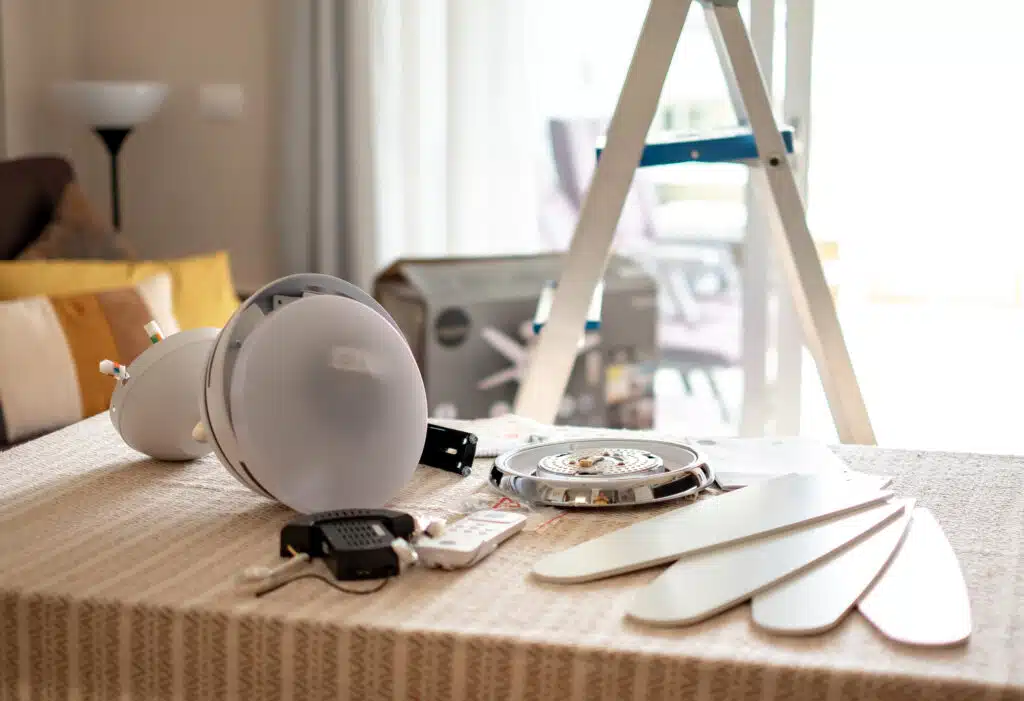Carbon monoxide detectors are essential for your home’s safety because you can’t see it, smell it, or taste it—but carbon monoxide (CO) can be deadly. Carbon monoxide is a sneaky gas that’s produced when fuel is burned. It can build up in your home from things like gas stoves, furnaces, or even a car running in the garage.
The scary part? You’d never know it’s there until it’s too late. That’s why carbon monoxide detectors are so important. They act like a watchdog, sniffing out CO in the air and warning you before it can harm you or your family.
What Is Carbon Monoxide and Why Is It Dangerous?
Understanding Carbon Monoxide
Carbon monoxide (CO) is an invisible gas that poses serious dangers because it has no color, smell, or taste. It is created whenever fuel, such as gas, wood, or charcoal, is burned, making it a byproduct of many common household activities.
Appliances like gas stoves, furnaces, or fireplaces rely on burning fuel and can produce CO under normal operation. When these appliances are working correctly, CO is safely vented out of the home, but any malfunction can lead to CO buildup inside. This is why it’s essential to be aware of CO sources in your home and ensure they’re properly maintained.
Common Sources of CO in Homes
Carbon monoxide is most often released from appliances and systems that burn fuel, making certain areas of the home more prone to CO buildup. Gas-powered stoves, furnaces, water heaters, and fireplaces are common culprits if they aren’t vented or maintained properly.
Running a generator too close to the house or leaving a vehicle running in an attached garage are also risky behaviors that can quickly lead to CO exposure.
Blocked chimneys or vents can trap CO indoors, especially during colder months when fireplaces and heating systems are used more often. Any issue with ventilation or improper use of these systems can create dangerous CO levels in the home.
Health Risks
The health risks associated with carbon monoxide exposure range from mild symptoms to life-threatening conditions. At lower levels, CO exposure may cause headaches, dizziness, or nausea, which can often be mistaken for other common illnesses.
As exposure increases, symptoms worsen, leading to confusion, shortness of breath, and even fainting. High levels of CO can cause unconsciousness and death, making it one of the most dangerous hazards in the home.
Children, the elderly, and individuals with respiratory conditions are especially vulnerable to its effects. A carbon monoxide detector is a critical tool to alert you before exposure reaches harmful levels.

The Role of Carbon Monoxide Detectors
Early Warning System
Carbon monoxide detectors are your first line of defense against the invisible danger of CO. These devices are designed to sense rising CO levels in the air and sound an alarm before they reach harmful concentrations.
This early warning gives you the crucial time needed to take action, such as ventilating your home or evacuating until the problem is resolved.
Without a detector, it’s impossible to know there’s a problem until symptoms appear, which could already be too late. By installing a carbon monoxide detector, you’re taking a proactive step to protect your household from a silent but deadly threat.
Essential for Enclosed Spaces
Carbon monoxide tends to accumulate in enclosed or poorly ventilated spaces, making detectors especially important in these areas. Bedrooms are critical locations since you could be exposed while sleeping, unable to recognize the symptoms of CO poisoning.
Basements and garages, where fuel-burning appliances or running vehicles are commonly found, are also high-risk zones. Even spaces that seem well-ventilated can trap CO if ventilation systems fail or vents become blocked. Installing detectors in these key areas ensures you’re protected wherever CO buildup is most likely to occur.
Complements Smoke Detectors
While smoke detectors protect you from visible dangers like fire, carbon monoxide detectors guard against an invisible threat. Both devices are essential for comprehensive home safety since they address entirely different hazards.
Some modern detectors combine smoke and CO detection, providing an all-in-one solution for your peace of mind. A CO detector fills the gap left by smoke alarms, ensuring your family is protected from multiple risks. Together, they create a complete safety net that helps prevent tragedies from avoidable home hazards.
Why Every Home Needs Carbon Monoxide Detectors
Prevents Tragedy
Carbon monoxide poisoning is a leading cause of accidental deaths in homes, but it is entirely preventable with the right precautions. Every year, hundreds of lives are lost due to exposure to this deadly gas, often because there are no detectors in place to alert occupants.
A functioning carbon monoxide detector can make the difference between a close call and a tragic outcome. By detecting CO early, these devices provide the time needed to address the issue before anyone is harmed. Installing detectors is a simple step to prevent heartbreak and keep your family safe.
Affordable Protection
When compared to the cost of potential medical bills or home repairs caused by CO poisoning incidents, carbon monoxide detectors are a small investment. Most models are affordable and readily available at home improvement stores, making them accessible to nearly every homeowner.
Many modern detectors are easy to install and come with long-lasting batteries or plug-in options. Given the life-saving potential they provide, they’re one of the most cost-effective safety measures you can take. Protecting your family doesn’t have to break the bank, and with detectors, peace of mind is well within reach.
Peace of Mind
Knowing your home is protected by carbon monoxide detectors brings a sense of reassurance that’s hard to put a price on. These devices allow you to go about your day or sleep through the night without the constant worry of unseen dangers.
During winter months, when heaters and fireplaces are used frequently, that peace of mind becomes even more valuable. Homeowners in areas like Lancaster, York, and Harrisburg, PA, can feel confident that their families are safe, even during the coldest nights. A small effort today ensures your loved ones are secure tomorrow.
Where to Place Carbon Monoxide Detectors in Your Home
Near Bedrooms
Placing carbon monoxide detectors near bedrooms is crucial to ensure they alert you while you sleep. The alarm needs to be loud enough to wake you up in case of a CO leak, as many incidents occur overnight when heaters or furnaces are running.
Install detectors within the hearing range of every sleeping area to provide maximum protection for your family. This placement gives you a vital warning before CO exposure leads to symptoms like dizziness or unconsciousness. Keeping your detectors close to where you rest adds a critical layer of safety.
On Every Level
To ensure comprehensive coverage, it’s important to install at least one carbon monoxide detector on every level of your home, including the basement. CO can rise and spread throughout your house, so having detectors on each floor increases the likelihood of early detection.
For multi-level homes, this setup ensures that even if CO originates in a distant part of the house, you’ll be alerted promptly. Remember that basements, where many fuel-burning appliances are located, are often a hot spot for CO buildup. A detector on every level minimizes the chances of missing a dangerous gas leak.
Near Fuel-Burning Appliances
Placing carbon monoxide detectors near appliances that burn fuel, such as stoves, furnaces, or water heaters, is another essential step. These are the most common sources of CO in homes, so monitoring them closely can help catch leaks or malfunctions early.
However, it’s important to follow the manufacturer’s recommendations for placement, as detectors should not be too close to the appliances to avoid false alarms. Proper positioning allows the detector to pick up on actual threats without interference from regular appliance use.
Avoid Problematic Locations
While it’s important to cover key areas, avoid placing detectors in spots like bathrooms, garages, or excessively dusty or humid environments. These areas can lead to false alarms or prevent the detector from functioning properly.
Additionally, detectors placed too low to the ground may not work efficiently, as CO mixes evenly in the air. Following these guidelines ensures your detectors operate accurately and reliably when you need them most.
How to Maintain Carbon Monoxide Detectors
Test Regularly
Testing your carbon monoxide detectors regularly is one of the simplest yet most important steps to ensure they’re working properly. Make it a habit to press the test button on each detector at least once a month. This quick check ensures the alarm will sound if CO is detected and helps you catch any malfunctions early.
Regular testing also familiarizes you with the alarm sound, so you’ll recognize it immediately in an emergency. Taking a few minutes each month can provide lifesaving reassurance.
Replace Batteries
Even the best carbon monoxide detectors won’t do their job if the batteries are dead. Replace the batteries in your detectors at least once a year or as recommended by the manufacturer. Many modern models will chirp or display a warning when the battery is running low, so don’t ignore these alerts.
To make it easy to remember, align battery replacement with a recurring event, like the start of daylight saving time. Keeping fresh batteries in your detectors ensures they’re always ready to protect your home.
Monitor Expiration Dates
Carbon monoxide detectors don’t last forever, and most models need to be replaced every 5 to 10 years. Over time, the sensors can degrade, reducing their ability to detect CO accurately.
Check the expiration date on your detectors or look for a label with the manufacturing date. If your detector is nearing the end of its lifespan, replace it promptly to maintain your safety. Staying on top of expiration dates ensures your home always has reliable protection.
Clean Periodically
Dust and debris can block the sensors in your carbon monoxide detectors, interfering with their ability to work properly. Clean the detectors periodically by gently vacuuming or wiping them with a soft cloth.
Avoid using harsh chemicals or sprays, as these can damage the sensors. Keeping your detectors clean ensures they stay sensitive to CO levels and function as intended. Simple maintenance like this helps extend the life of your detectors and keeps them in top shape.
Key Features to Look for in a Carbon Monoxide Detector
Alarm Volume
A carbon monoxide detector’s alarm needs to be loud enough to wake you, especially if CO levels rise while you’re sleeping. Look for models with alarms that exceed 85 decibels, as this ensures the sound is audible throughout the home.
A strong, piercing alarm is critical for grabbing attention quickly, even from a distance. When testing detectors, make sure the sound is clear and unmistakable to help avoid confusion in an emergency. A loud alarm could make all the difference in keeping your family safe.
Digital Display
Many modern carbon monoxide detectors include a digital display that shows real-time CO levels. This feature allows you to monitor low levels of CO before they become dangerous, giving you valuable insight into your home’s air quality.
Detectors with digital displays are particularly useful for tracking trends, such as small leaks from appliances. Some models even provide historical data, making it easier to identify recurring issues. Having this level of awareness enhances your ability to respond quickly to potential problems.
Battery Backup
Even if your detector is hardwired into your home’s electrical system, having a battery backup is essential. During power outages, especially in winter when heaters are running, the risk of CO exposure can increase.
A battery backup ensures your detectors remain functional, even when the lights go out. Look for models with long-lasting batteries that require minimal replacement. This added reliability provides peace of mind, no matter the situation.
The Role of Professional Services in CO Detector Installation
Expert Placement
When it comes to installing carbon monoxide detectors, professional services ensure they are placed in the best locations to provide maximum safety. Trained technicians understand where CO is most likely to accumulate, such as near bedrooms, basements, or areas with fuel-burning appliances.
They also know how to avoid improper placement, such as too close to a stove or in overly humid locations, which can cause false alarms.
Professionals make sure your carbon monoxide detectors are strategically installed for optimal effectiveness. This expert guidance can help you feel confident that your home is as safe as possible.
Compliance With Local Codes
In areas like Lancaster, York, and Harrisburg, PA, building codes may require carbon monoxide detectors in specific parts of the home, especially in newer constructions. Professional installation services ensure your detectors meet these legal requirements, giving you peace of mind that your home is both safe and compliant.
Failing to adhere to local codes can lead to fines or, worse, inadequate protection for your family. By working with a professional, you’ll know your carbon monoxide detectors are properly installed according to all relevant safety regulations.
Integration With Home Systems
For homeowners looking to enhance convenience, professionals can integrate carbon monoxide detectors with existing home security or smart systems. This means you can receive alerts directly to your smartphone, even if you’re not home, allowing you to take immediate action.
Integrated systems also enable centralized control, making it easier to manage and test your detectors. By linking carbon monoxide detectors to a smart home system, you ensure round-the-clock protection with advanced features that offer added security and peace of mind.
Stay Safe: Protect Your Home with Mister Sparky of Lancaster
Don’t wait until it’s too late to safeguard your family from hidden dangers. Mister Sparky of Lancaster proudly serves Lancaster, York, and Harrisburg, PA, providing expert installation of life-saving CO detectors.
Our team ensures your home is protected with properly placed and maintained devices. Call today to schedule your appointment and let us help you create a safer, worry-free home environment for your loved ones.

Frequently Asked Questions (FAQ)
1. How often should carbon monoxide detectors be tested?
Carbon monoxide detectors should be tested at least once a month to ensure they are functioning properly. Use the test button on the device to make sure the alarm sounds. Regular testing is important to catch any malfunctions before they become an issue.
2. Can carbon monoxide detectors detect natural gas leaks?
No, carbon monoxide detectors are designed to detect CO gas, not natural gas or propane. If you’re concerned about gas leaks, you’ll need a separate gas leak detector to provide that specific protection.
3. What should I do if my carbon monoxide detector alarm goes off?
If your carbon monoxide detector alarm sounds, immediately get everyone out of the house and into fresh air. Call 911 or your local fire department to report the alarm. Do not re-enter the home until the issue has been resolved and it is deemed safe by a professional.
4. Are plug-in models effective?
Yes, plug-in models are effective, but they should include a battery backup to ensure they work during power outages. This is especially important since CO risks often increase when heating systems are in use during winter storms.
5. Where should these alarms be installed?
Place alarms on every level of your home, near bedrooms, and close to fuel-burning appliances like stoves or furnaces. Avoid installing them in overly humid or dusty areas, such as bathrooms or garages, to reduce the chance of false alarms.


































